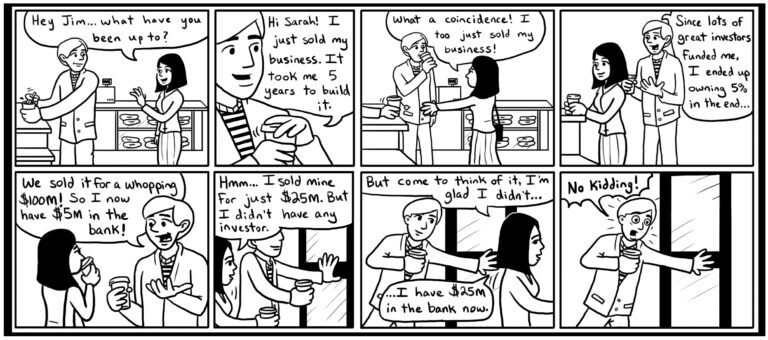Best of Bootstrapping: Bootstrapped by Piggybacking from Romania

If you haven’t already, please study our Bootstrapping Course and Investor Introductions page.
You may have read our PaaS coverage, as well as Bootstrapping by Piggybacking posts. Well 123FormBuilder CEO Florin Cornianu has built a $6 million SaaS business using this methodology with just $1 million in funding. What’s more, he has done it entirely from Romania and sells to largely a US customer base. Excellent story!
Sramana Mitra: Let’s start at the very beginning of your journey. Where are you from? Where were you born, raised, and in what kind of background?
Florin Cornianu: I’m the CEO and Co-founder of 123FormBuilder. We are a form-building SaaS. The company is in Romania. I was born in a small city in the northern part of Romania. I’m an engineer by profession. I graduated with computer science degree from a large university in the city where I live.
Featured Videos
Cloud Stocks: Analysis of Adobe’s $20B Figma Acquisition

Adobe (NASDAQ: ADBE) recently reported its quarterly results that continued to outpace market expectations. But the biggest news for the company was its $20 billion acquisition of Figma, a small design startup.
>>>Twin Brothers Building a FinTech Venture: Stephen Roche and Gabino Roche, CoFounders of Saphyre (Part 3)
Sramana Mitra: Let’s come to the year that you started Saphyre. What year was that?
Gabino Roche: 2017. I remember it was scary. To do work in finance, you had to go all in. I told you about my three failed businesses and the one that broke even. In this case, if I’m going to do it, I have to do it full-time. There’s no financial institution that would do business with you if you’re doing a part-time gig. That’s why when Stephen said he would back me and pay for my salary for a year, I had to fully commit.
Sramana Mitra: In 2017 when you decided to do Saphyre, what were you going to do?
>>>Video FAQs
Can 1M/1M Help Me Raise Money?
How Does 1M/1M Democratize Entrepreneurship Education?
How Does 1M/1M Democratize Management Consulting?
When Is The Right Time To Join 1M/1M?
Can 1M/1M Help Me With Business Development?
Can 1M/1M Help Me With Market Sizing?
Can 1M/1M Help Me Validate My Product?
Will I Have Private 1-on-1 Sessions In 1M/1M?
How Does 1M/1M Help Entrepreneurs Connect With Silicon Valley?
Mentoring or Consulting?
Why Does 1M/1M Charge $1000 a Year?
Why Does 1M/1M Partner With Local Organizations?
Why Don\’t Mentoring Networks Work?
Why Is It Important To Study With 1M/1M Now?
Dan Stewart Story
Vikrant Mathur Story
Best of Bootstrapping: Bootstrapped Using Service from Wisconsin

If you haven’t already, please study our Bootstrapping Course and Investor Introductions page.
SignalWire Founder CEO Anthony Minessale is building a very interesting programmable communication platform company that has its roots in Wisconsin. This conversation is from 2020.
Sramana Mitra: Let’s start at the very beginning of your journey. Where are you from? Where were you born, raised, and in what kind of background?
Anthony Minessale: I’m from the Midwest. I live in Wisconsin where I’ve lived all my life. I have been involved in computers since high school. After high school, I became interested in how the internet works. At that time, the internet was starting to take off. I started to teach myself programming.
1Mby1M Virtual Accelerator Investor Forum: With Yanev Suissa, Managing Partner and Founder at SineWave Ventures (Part 2)
Sramana Mitra: When something fits your investment thesis, what do you want to see in the company when you’re doing a seed investment? What is the earliest stage check that you’re comfortable writing and what do you want to see? Do you want to see paying customers or a certain MRR?
Yanev Suissa: A lot of these firms have, what I would call, nonsensical rules. Some of that is indicative of how a startup is performing, but I don’t think it should be a barrier. Our seed deals are not pure tech risk in that a product is already developed. It may not have all the features and it may not be in scale, but it’s deployed in some way so you can test it and play with it.
>>>Cloud Stocks: Pure Storage Focuses on Flexible Customer Offerings

According to a recent report, the global NAND flash memory market is expected to grow at 5% CAGR from $66.52 billion in 2021 to reach $94.24 billion by 2027. The current macro trends of AI and machine learning, mobility, and connectivity are helping drive the growth in this market. Pure Storage (NYSE: PSTG) recently reported its second-quarter results that surpassed market expectations.
>>>Twin Brothers Building a FinTech Venture: Stephen Roche and Gabino Roche, CoFounders of Saphyre (Part 2)
Sramana Mitra: You learn a tremendous amount in failures. It gives you the time to pivot. There are a lot of pivots involved in finding product-market fit. Having the time to do that pivot without going bankrupt is very helpful.
Gabino Roche: Just to tie to the freedom of failure and pivoting, at the mobile app company I was running, when you come up with an idea like Saphyre and you’re trying to get clients to adopt it; you may have an initial idea that’s really good, but you have to put yourself in the selfish interest of the potential partners and clients that you want to win. You may want to build something else to get to your idea.
>>>1Mby1M Virtual Accelerator Investor Forum: With Yanev Suissa, Managing Partner and Founder at SineWave Ventures (Part 1)

Yanev Suissa, Managing Partner and Founder at SineWave Ventures, discusses his firm’s successes as well as its investment thesis. Vertical Cloud is one of the key ones with an emphasis on Enterprise Data Platforms.
Sramana Mitra: You have big news. Let’s catch up.
Yanev Suissa: We did big closings on our third fund. Our performance has been top 5 percentile in the industry. We’ve been doing a great job. Things have been chugging along at SineWave.
>>>